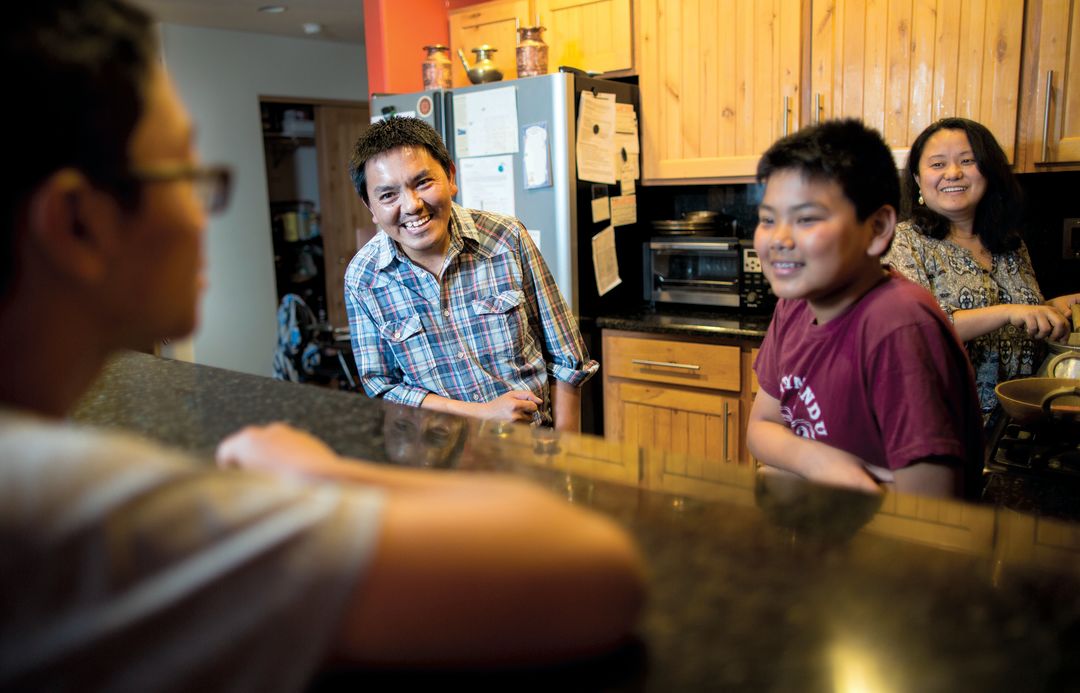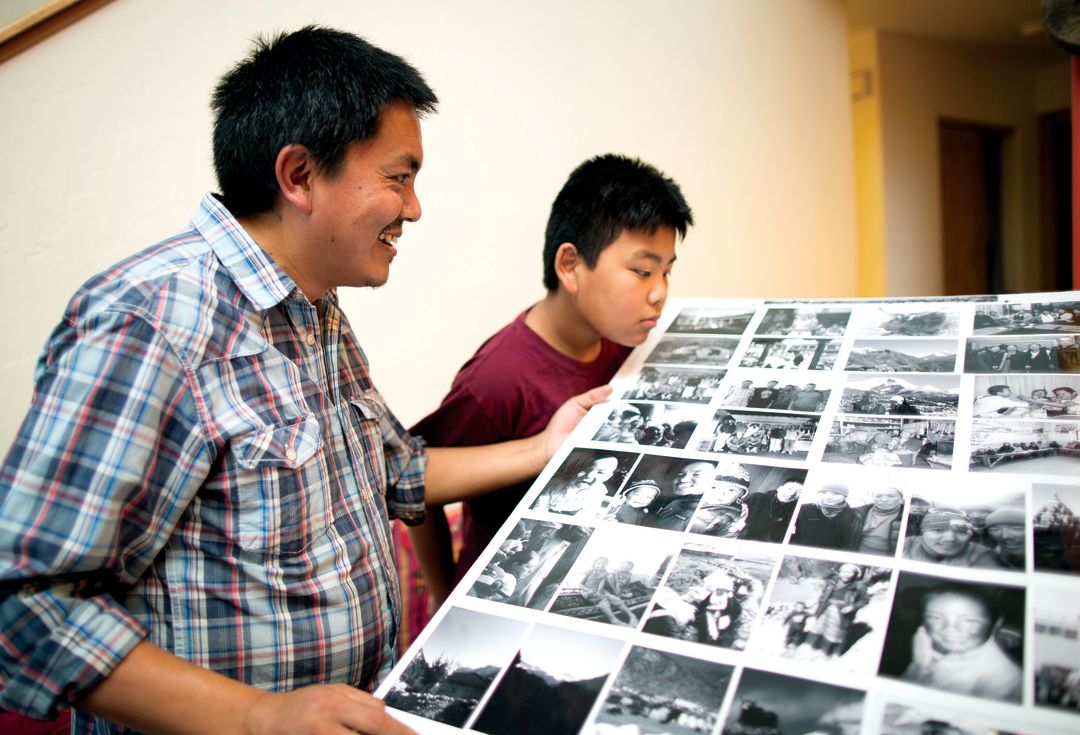From Everest to Edwards
I was born on a Sunday in 1974 in Phortse, a small village of about 60 houses and maybe 250 people at 3,879 meters in the Khumbu Valley of Nepal. “Neema” means Sunday; Nepalese people are usually named after the day of the week on which they are born. Phortse is on the way to Mount Everest. It’s very scenic, very pretty. Everywhere you look, on the right, on the left, you see mountains.
We are a big family, five brothers and two sisters. My dad, Pemba Tharké Sherpa, climbed all his life. He climbed with Sir Edmund Hillary on early expeditions to many different mountains, and in 1972, on Sir Christian Bonington’s summit attempt up Everest’s southwest face, my dad served as sirdar, the most experienced guide who manages logistics and all the Sherpas on an expedition. He climbed until he was around 50 years old and we convinced him that he should retire.
My mother worked in the fields tending potatoes and buckwheat, and me and my brothers and sisters would help herd and milk the yaks. We had a two-story house. The first floor is where we put all the yak babies and the wood for the winter, and the second floor is where we lived and slept, mostly all together.

Image: Dominique Taylor
In summertime, we would leave the main house for seven months and keep moving from place to place so our yaks could have better grass. Sometimes I went with the yaks to places where people needed help carrying their loads, their stuff. When I was 14 or 15, that’s when I started as a helper in trekking, taking Western tourists from Phortse to Everest base camp. For a typical Sherpa person, it takes about six hours to walk from the village to Everest base camp; for a Western trekker it’s maybe three days.
When I was 16 I moved to Katmandu, where I attended school part-time and worked for my brother, who was a partner in a guiding company. The climbing season is typically April and May, and then it picks up again September, October, and November; five months out of the year is when you make most of your money. I guided for maybe eight years, mostly trekking to Everest base camp and a lot of smaller trekking peaks—sometimes to Annapurna, which would take 16 days. The highest peak I climbed was 6,000 meters, Imja Tse (Island Peak), in Khumbu close to Everest.
The first time is not easy; you get nervous. I remember being on the top of Imja Tse, but I don’t remember the whole way up there. My brother and his friend, they would be fixing rope—they led the climb. I would carry rope and maybe two tents, a load weighing maybe 30 pounds. It was not an easy climb, especially coming down. Looking back, I don’t think I was a very skilled climber, but we got the job done.
I came to the United States the first time in 1998. There was this guy from Utah; I guided him in Nepal, and he wanted to buy a rickshaw, so I helped him buy it. We e-mailed a lot, and he asked if I wanted to come visit the United States, and he said he would help me with my ticket. So I went to the embassy and got a tourist visa, and I went to New York. A couple from Boston that I guided in Nepal picked me up at the airport. I spent a lot of time with them, visiting New York and a lot of places on the East Coast.

Image: Dominique Taylor
I was here for as long as I could stay—two months—and when I went back, I made up my mind that I would come and live here. I could find work, make more money, and maybe help out one or two of my brothers. Typically in a year in Nepal, I would earn $1,000. But there’s no electricity bill or mortgage. When you’re thirsty, you go get water. When you’re hungry, you milk the yak, you go get potatoes. So if you are young and single, that $1,000 will give you a decent life.
A year later, when I was 24, I moved to the United States. I lived in New York City for seven years. I worked many different jobs: I washed dishes in a restaurant, I drove a taxi, I did construction work. In 2006, I came to Colorado to visit two Sherpa friends who live in Vail. I really liked it here. In summer it is beautiful.
The mountains remind me of home. It’s just like you’re living in Nepal, except you are driving everywhere! There are 12, maybe 14 Sherpa families here, some living in Gypsum, some in Eagle, some in Eagle-Vail. People look at us and think maybe we are Filipino, maybe we are from Mexico. They don’t have a clue.
My wife, Nima, is from Katmandu. My boys were both born here: Tenzing, he is 15, his name was given by his holiness the Dalai Lama; Dorje—that means “thunderbolt”—he’ll be 12 in March. I work as an attendant at the Edwards Station car wash. I keep inventories for everything, speak with vendors, fix little things, and interact with a lot of people. I like fixing things, plus, I get to be outside.
On my coffee table I have a copy of Outside magazine from April 2003, about the 50th anniversary of Hillary’s ascent of Everest. Inside, there’s a story about Pemba Tharké Sherpa, with his picture. He died last May. He was 76. Now every year, my wife and I send money to an organization in Nepal, and on the day he died they feed 350 hungry people in Katmandu dinner, in his memory.
I knew one or two of the guys who died on Everest last year, knew them really well from when I was guiding in Katmandu. I heard about the accident on the radio, on NPR, before I went to work. All my brothers and a lot of my cousins are still very much involved in expeditions, and they were all up there. I tried to call the phone at Everest base camp—I still have the number—but the call wouldn’t go through, so I got scared. But later my sister called from Phortse, saying everybody is OK.
I still want to climb to the summit of Everest. I don’t know if it will turn into a reality, but it is a goal. Why? It is a feeling you have inside. My younger brother, who is 23, has summited Everest nine or 10 times; my other brother, who is 32, has summited seven or eight times. But really, it has nothing to do with a family badge of honor. I would just like to go to see how you feel up there.
Before Tenzing leaves us, I would like him and his brother to spend a summer in Phortse. They have never been to my village, but I would like them to see where they come from. To get to Phortse, you must fly into Lukla—it’s the world’s most dangerous airport—then from the airport you must walk. For my wife and children, it will probably take three days. For me, I think maybe one.






































